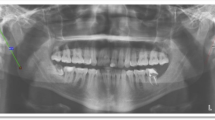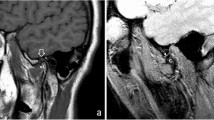Abstract
The aim of the current study was to determine the presence of styloid process elongation (SPE) detected on panoramic radiographs in patients with torus palatinus (TP). Between December 2005 and November 2007, a total of 149 patients with TP are investigated for routine dental examination in the outpatient clinic. Any patient who had disorders related to calcium and phosphorus metabolism was excluded. All medical data were obtained from the files. Twenty (15%) subjects demonstrated SPE at least one side. These patients consisted of 15 women (14.3% of all women) and five men (17.8% of all men). In our previous report performed in normal population at the same region, the prevalence had been found to be 7.7% in 698 dental patients. Although the number of the patients is different in both studies, there is a marked difference in terms of the SPE prevalence between the two reports. This prevalence difference might be related to concomitant disorder.

Similar content being viewed by others
References
Baudoin C, Cohen-Solal ME, Beaudreuil J, De Vernejoul MC (2002) Genetic and environmental factors affect bone density variances of families of men and women with osteoporosis. J Clin Endocrinol Metab 87:2053–2059
Belsky JL, Hamer JS, Hubert JE, Insogna K, Johns W (2003) Torus palatinus: a new anatomical correlations with bone density in postmenopausal women. J Clin Endocrinol Metab 88:2081–2086
Neville BW, Damm DD, Allen CM, Bouquot JE (1996) Developmental defects of the oral and maxillofacial region. In: Neville BW, Damm DD, Allen CM, Bouquot JE (eds) Oral and maxillofacial pathology. Saunders, Philadelphia, pp 1–43
Cagirankaya LB, Kansu O, Hatipoglu MG (2004) Is torus palatinus a feature of a well-developed maxilla? Clin Anat 17:623–625
Carter L (2004) Soft tissue calcification and ossification. In: White SC, Pharoah MJ (eds) Oral radiology, principles and interpretation. Mosby, Missouri, pp 597–614
Chuang WC, Short JH, McKinney AM, Anker L, Knoll B, McKinney ZJ (2007) Reversible left hemispheric ischemia secondary to carotid compression in Eagle syndrome: surgical and CT angiographic correlation. Am J Neuroradiol 28:143–145
Eagle WW (1937) Elongated styloid process. Report of two cases. Arch Otolaryngol 25:548–587
Gokce C, Sisman Y, Sipahioglu M, Ertas ET, Akgunlu F, Unal A, Tokgoz B, Oymak O, Utas C (2008) The prevalence of carotid artery calcification on the panoramic radiographs of end-stage renal disease patients with peritoneal dialysis: do incidental findings provide life-saving information? J Int Med Res 36:47–53
Gokce C, Sisman Y, Tarim Ertas E, Akgunlu F, Ozturk A (2008) Prevalence of styloid process elongation on panoramic radiography in the Turkey population from Cappodocia region. Eur J Dent 2:18–22
Gorsky M, Bukai A, Shohat M (1998) Genetic influence on the prevalence of torus palatinus. Am J Med Genet 75:138–140
Hjertstedt J, Burns EA, Fleming R, Raff H, Rudman I, Duthie EH, Wilson CR (2001) Mandibular and palatal tori, bone mineral density, and salivary cortisol in community-dwelling elderly men and women. J Gerontol A Biol Sci Med Sci 56:M731–M735
Ilguy M, Ilguy D, Guler N, Bayirli G (2005) Incidence of the type and calcification patterns in patients with elongated styloid process. J Int Med Res 33:96–102
Jung T, Tschernitschek H, Hippen H, Schneider B, Borchers L (2004) Elongated styloid process: when is it really elongated? Dentomaxillofac Radiol 33:119–124
Keur JJ, Campbell JP, McCarthy JF (1986) The clinical significance of the elongated styloid process. Oral Surg Oral Med Oral Pathol 61:399–404
Kursoglu P, Unalan F, Erdem T (2005) Radiological evaluation of the styloid process in young adults resident in Turkey’s Yeditepe University Faculty of Dentistry. Oral Surg Oral Med Oral Pathol Oral Radiol Oral Endod 100:491–494
Murtagh RD, Caracciolo JT, Fernandez G (2001) CT findings associated with Eagle syndrome. Am J Neuroradiol 22:1401–1402
Okabe S, Morimoto Y, Ansai T, Yamada K, Tanaka T, Awano S, Kito S, Takata Y, Takehara T, Ohba T (2006) Clinical significance and variation of the advanced calcified stylohyoid complex detected by panoramic radiographs among 80-year-old subjects. Dentomaxillofac Radiol 35:191–199
Prasad KC, Kamath MP, Reddy KJ, Raju K, Agarwal S (2002) Elongated styloid process (Eagle’s syndrome): a clinical study. J Oral Maxillofac Surg 60:171–175
Tran KT, Shannon M (2007) Images in clinical medicine. Torus palatinus. N Engl J Med 356:1759
White SC, Pharoah MJ (2004) Benign Tumors of the Jaws. In: White SC, Pharoah MJ (eds) Oral radiology, principles and interpretation. Mosby, Missouri, pp 410–547
Yildiz E, Deniz M, Ceyhan O (2005) Prevalence of torus palatinus in Turkish schoolchildren. Surg Radiol Anat 27:368–371
Zaki HS, Greco CM, Rudy TE, Kubinski JA (1996) Elongated styloid process in a temporomandibular disorder sample: prevalence and treatment outcome. J Prosthet Dent 75:399–405
Conflict of interest
I/We have no conflicts of interest to declare in relation to this article.
Author information
Authors and Affiliations
Corresponding author
Rights and permissions
About this article
Cite this article
Sisman, Y., Gokce, C., Tarim Ertas, E. et al. Investigation of elongated styloid process prevalence in patients with torus palatinus. Clin Oral Invest 13, 269–272 (2009). https://doi.org/10.1007/s00784-008-0232-6
Received:
Revised:
Accepted:
Published:
Issue Date:
DOI: https://doi.org/10.1007/s00784-008-0232-6




